Key takeaways:
- Prevention education is vital for fostering safety, understanding, and open dialogue about societal issues, particularly in recognizing risks and promoting healthy relationships.
- Gender equality is crucial for societal fairness and economic growth, with the empowerment of women leading to broader benefits for communities and nations.
- Advocacy in education can transform policies and promote inclusivity, enabling informed discussions that encourage students to challenge stereotypes and advocate for equality.
- Effective educational strategies, such as experiential learning and peer-to-peer education, enhance engagement and help students relate gender issues to real-world contexts.
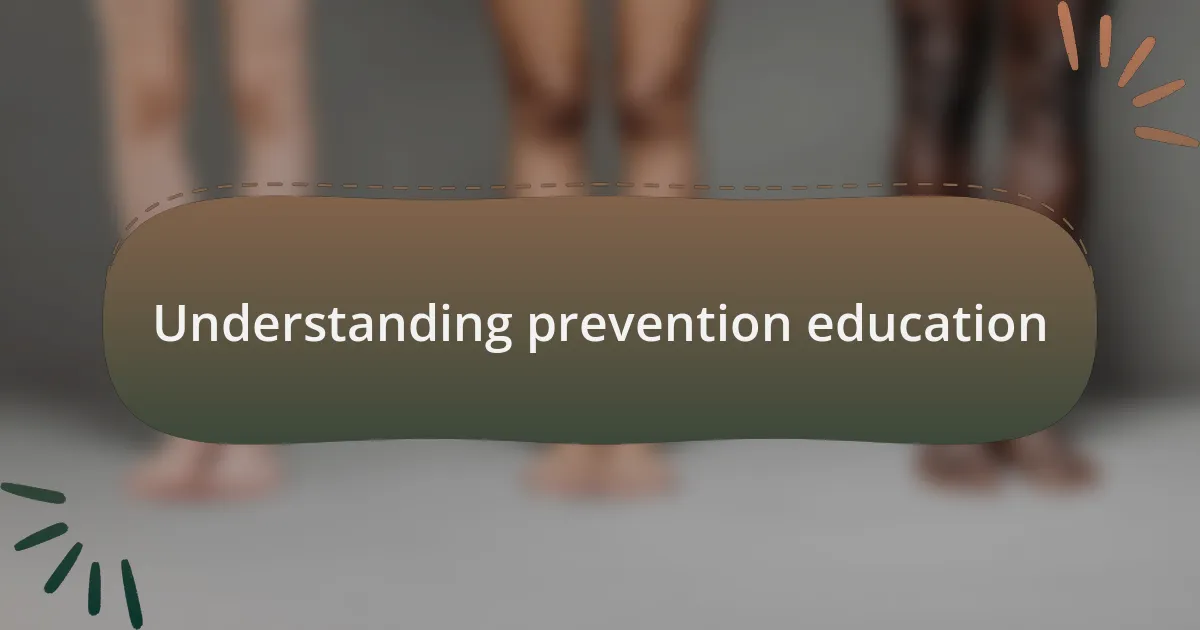
Understanding prevention education
Prevention education plays a crucial role in addressing various societal issues, from violence to discrimination. I remember a workshop I attended where the facilitator asked us, “What does sense of safety mean to you?” This simple question led to deep discussions about personal experiences and the importance of feeling secure in our environments, which is at the core of effective prevention education.
In essence, it’s about equipping individuals with knowledge and skills to recognize potential risks and respond appropriately. For instance, a friend of mine shared how a school program on consent opened her eyes to the nuances of healthy relationships. She realized that preventing issues starts with these early conversations, making me reflect on how vital it is to have proactive dialogues in our communities.
Moreover, I believe that understanding prevention education means acknowledging diverse perspectives and experiences. It’s not just about delivering a one-size-fits-all message. Have you ever thought about how different backgrounds can influence how we perceive risks? By embracing inclusivity in our educational efforts, we not only enhance the effectiveness of our messages but also foster a deeper sense of community and support.
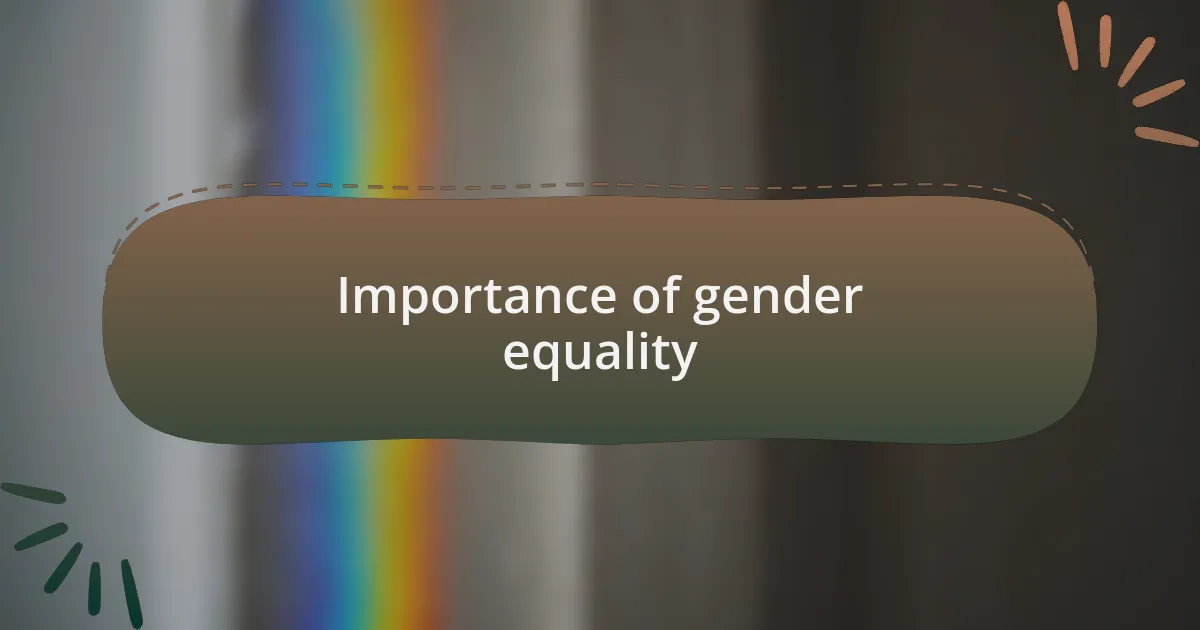
Importance of gender equality
Gender equality is essential for creating a fair and just society. I often think about how when both men and women have the same opportunities, everyone thrives. Take, for instance, the time I volunteered at a local organization focused on leadership development for young girls. Witnessing their confidence grow when they experienced equal support and encouragement was inspiring.
Moreover, gender equality has significant economic implications. Studies show that empowering women can boost economic growth in communities and nations. I can recall a conversation with a mentor who emphasized that when women engage in the workforce, entire households benefit. This connection between gender equality and economic prosperity really shifted my perspective on the broader implications of equality.
Additionally, equality fosters healthier relationships and communities. When individuals view each other as equals, respect and mutual understanding flourish. I have seen firsthand how my friendships have deepened when we all valued each other’s viewpoints equally. This leads me to wonder, how different would our society be if gender equality was truly prioritized in our everyday lives? The potential for positive change is immense.
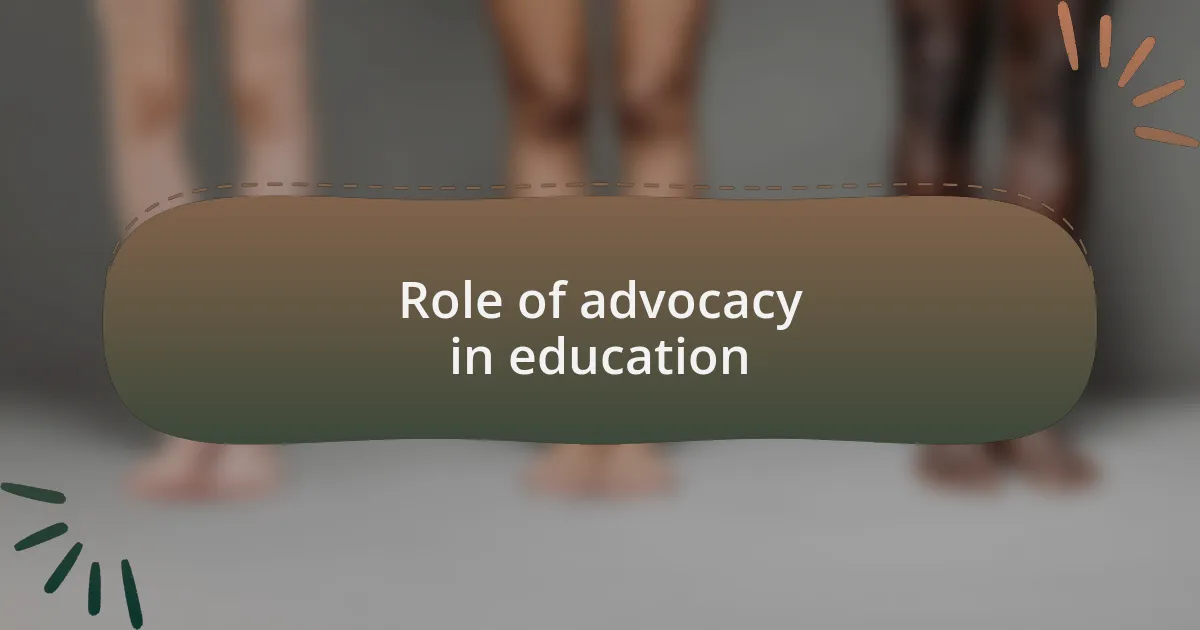
Role of advocacy in education
Advocacy plays a pivotal role in shaping education around gender equality. I remember attending a workshop where passionate speakers highlighted the stark gaps in educational resources for girls compared to boys. Their stories were eye-opening, making me realize how critical it is for advocates to push for systemic changes that ensure every child has access to quality education. How can we expect future generations to uphold equality if the very foundations of their learning are unequal?
In my experience, advocacy efforts have the power to transform educational policies, turning abstract ideals into tangible outcomes. I once worked alongside a group that successfully lobbied for the inclusion of gender studies in our local curriculum. The impact of this initiative was profound, as it not only educated students but also inspired them to challenge stereotypes. Isn’t it remarkable how informed youth can lead the charge for change in their communities?
Moreover, advocacy fosters a sense of community engagement that enriches the learning environment. I recall a school event where local leaders spoke about the importance of gender equality in careers, igniting energetic discussions among students. This interaction shifted perspectives and planted seeds for future advocacy. When we unite to champion equal opportunities in education, it doesn’t just elevate individuals; it cultivates a society that values and upholds gender equality for all.
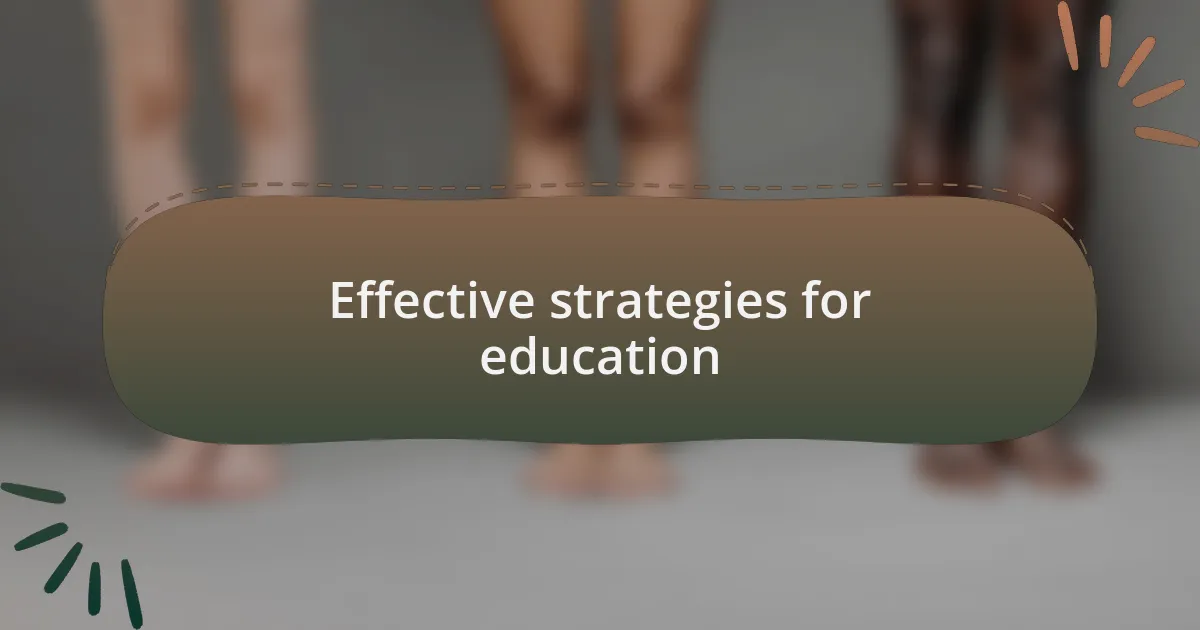
Effective strategies for education
Implementing hands-on experiential learning strategies is a game-changer in educational settings. I once participated in a program where students created multimedia projects on gender issues, allowing them to express their thoughts creatively. Watching their enthusiasm and seeing how they could relate these issues to their own lives reinforced my belief in the power of interactive education. What better way to learn and drive change than by letting students become storytellers in their own right?
Peer-to-peer education is another effective approach that I find invaluable. In one instance, I facilitated a workshop where older students mentored younger ones on understanding gender biases. The breakthrough came when I saw the younger students asking questions they hesitated to voice before. This exchange not only created a safe space but also nurtured empathy and understanding, empowering them to speak out against inequality. Isn’t it fascinating how learning from one another can deepen our collective resolve to challenge societal norms?
Finally, integrating real-world experiences into the curriculum can greatly enhance students’ awareness of gender issues. I remember organizing field trips to local organizations that advocated for women’s rights. Such experiences turned abstract concepts into lively discussions among students, as they encountered real challenges and victories in the community. By connecting education to the world outside the classroom, we foster an environment rich in learning and action. Isn’t it crucial that we equip students with the knowledge and passion to be advocates for equality in their future endeavors?
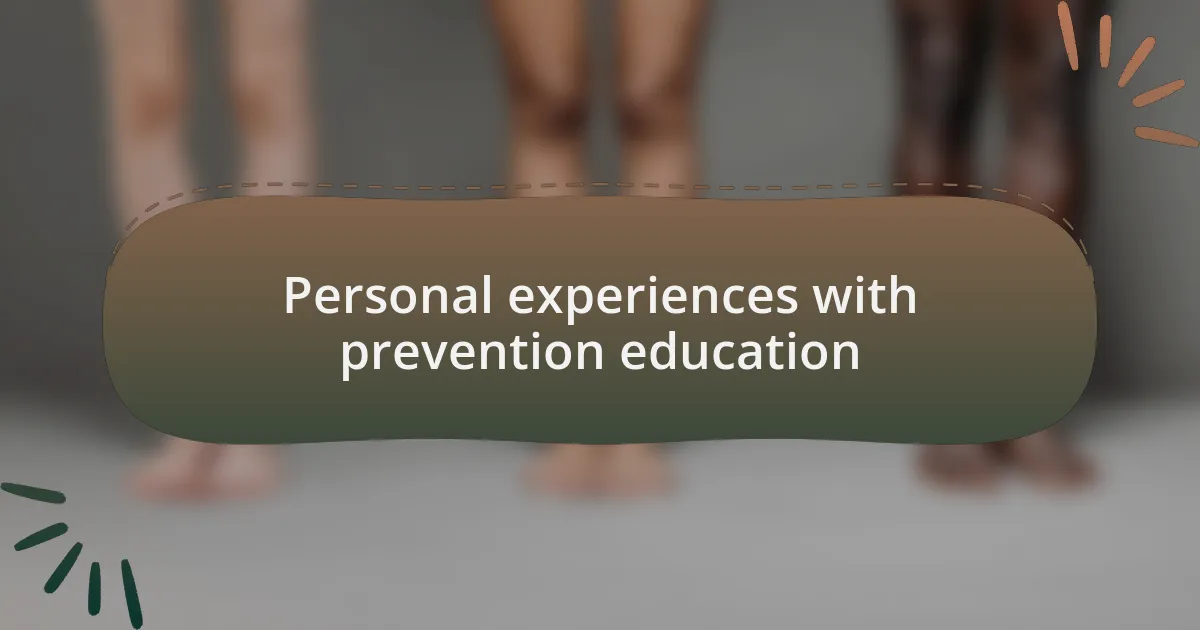
Personal experiences with prevention education
I vividly recall attending a prevention education workshop focused on intimate partner violence. The facilitator shared powerful survivor stories, which brought the harsh realities of these issues to the forefront. I found myself reflecting on how often we underestimate the impact of sharing personal narratives; it truly opened my eyes to the emotional weight behind statistics. How can we advocate for change if we don’t understand the lived experiences shaping these challenges?
Another experience that stands out for me was during a community event where we engaged attendees in a dialogue about consent. I remember a participant hesitating to voice their perspective due to previous misunderstandings about boundaries. It was incredible to watch their confidence grow as we unraveled misconceptions and fostered open discussion. Isn’t it amazing how a simple conversation can shift perspectives and foster a supportive community?
Lastly, I volunteered in a school program where we used art to explore themes of gender identity and expression. I witnessed how students used their creativity to articulate their feelings and experiences. One student penned a powerful poem about feeling like their true self for the first time. In that moment, I realized just how critical it is for education to provide outlets for self-expression. How often do we allow young voices the space to be heard and validated? It’s these moments that affirm my commitment to ensuring every student feels empowered to share their voice.
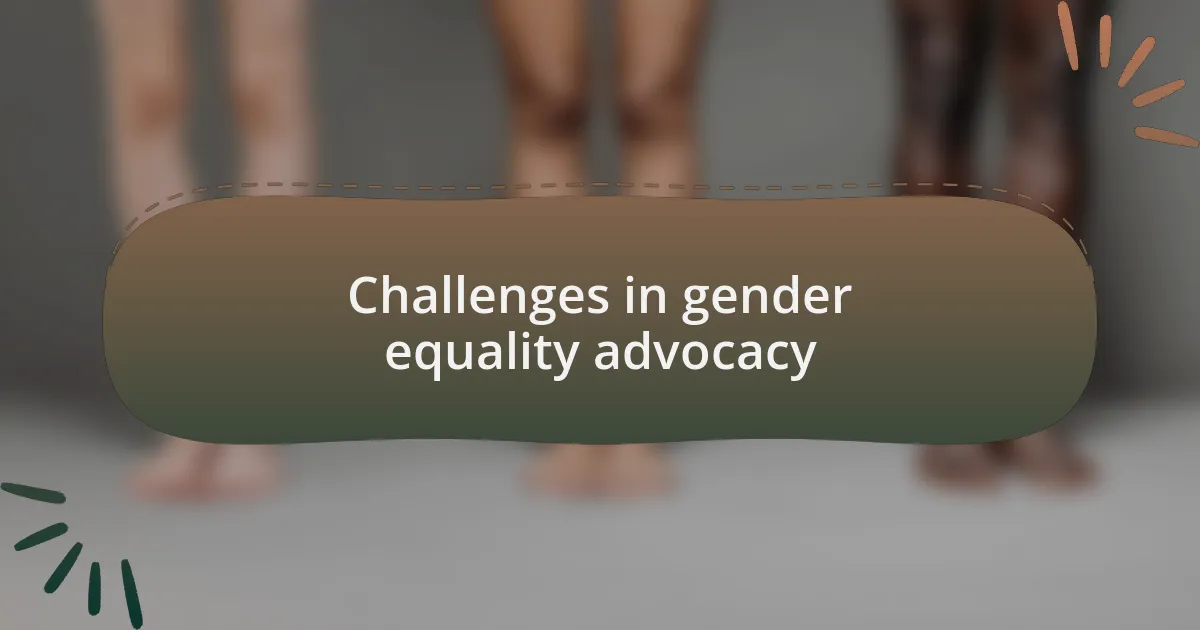
Challenges in gender equality advocacy
Advocating for gender equality often feels like navigating an uphill battle. I remember a time when I attempted to raise awareness about the pay gap within my organization. While I had solid data and passionate arguments, I was met with resistance and disbelief from some colleagues. How frustrating is it to face such pushback in the face of overwhelming evidence? It makes you wonder how deeply ingrained biases can dictate our responses to gender issues.
Another challenge I’ve encountered is the intersectionality of gender, race, and socioeconomic status. In discussions about equality, I’ve witnessed individuals from different backgrounds struggle to find common ground. For instance, during a forum, a participant shared their experience of discrimination that transcended gender alone; this layered complexity often complicates our efforts to unify and advocate for all. Isn’t it daunting to realize that one person’s fight for equality may look entirely different from someone else’s?
Lastly, I have noticed that the language we use can be a barrier. At times, I’ve found myself in discussions filled with jargon that excludes those who aren’t well-versed in gender studies. There was a workshop I attended where the facilitator used complex terms without providing context, leaving many participants confused. How can we expect change if our conversations alienate rather than invite? This realization drives me to advocate for simpler, more inclusive dialogue to empower everyone in the equality movement.
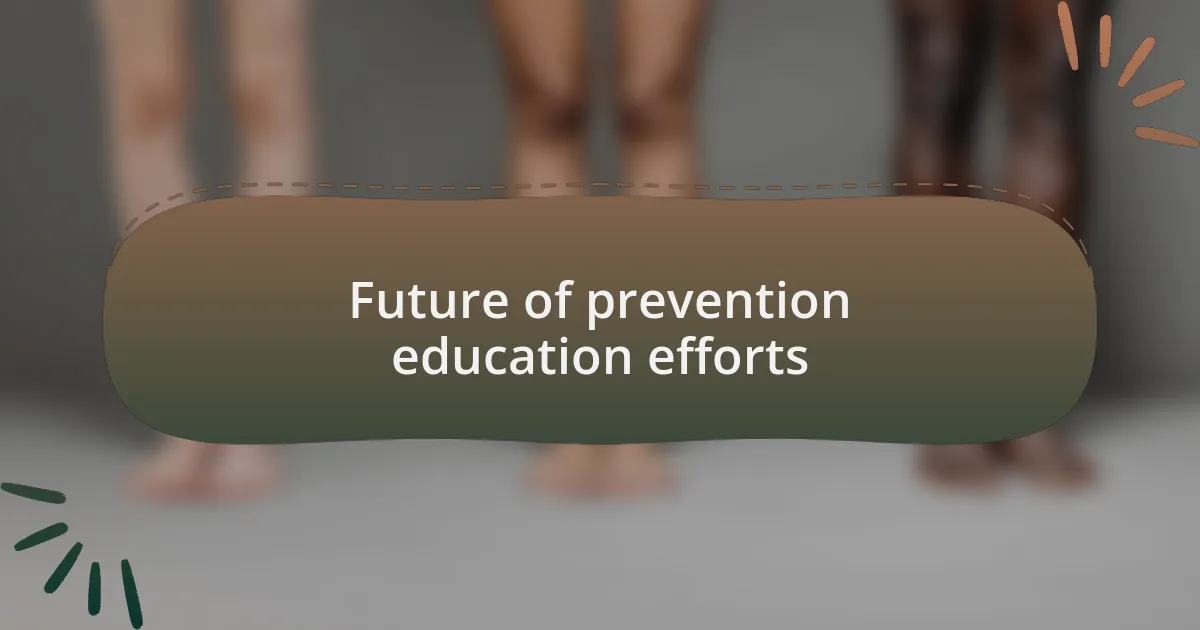
Future of prevention education efforts
The future of prevention education efforts in gender equality must focus on creating emotionally resonant content that resonates with diverse audiences. I recall a workshop I attended, where the facilitator shared personal stories of overcoming gender bias. It struck me how powerful these narratives were in driving home the importance of prevention education. How can we harness storytelling to make our message more relatable and impactful?
It’s essential that we rethink our educational strategies to be more inclusive and engaging. Recently, I participated in a community event where interactive activities, rather than lectures, facilitated open dialogues about gender issues. Witnessing people of all ages participate and learn from each other was exhilarating. Could this approach be the key to fostering understanding and empathy in the prevention education landscape?
Moreover, I believe collaboration between organizations will be vital for future efforts. A few months ago, I joined a coalition of local advocacy groups aiming to pool resources for prevention education initiatives. The synergy we created not only enhanced our reach but also allowed us to share knowledge and insights that were previously siloed. What if this spirit of collaboration became the norm, instead of the exception, in our approach to gender equality education?